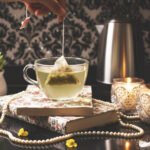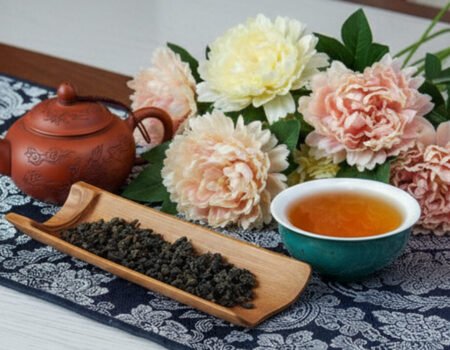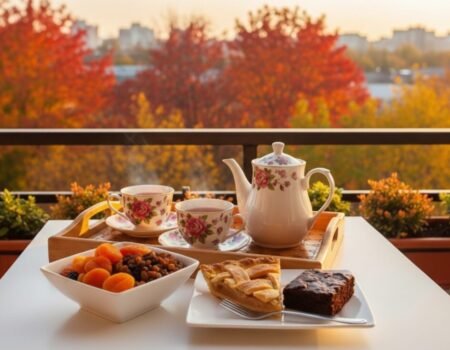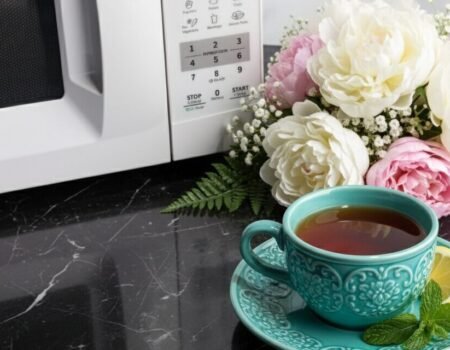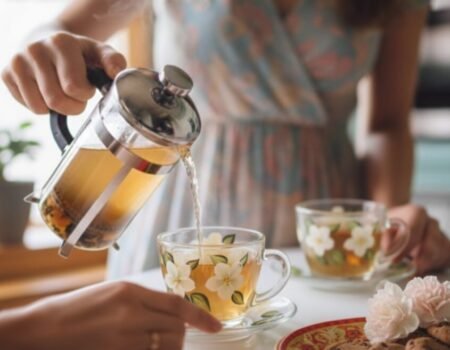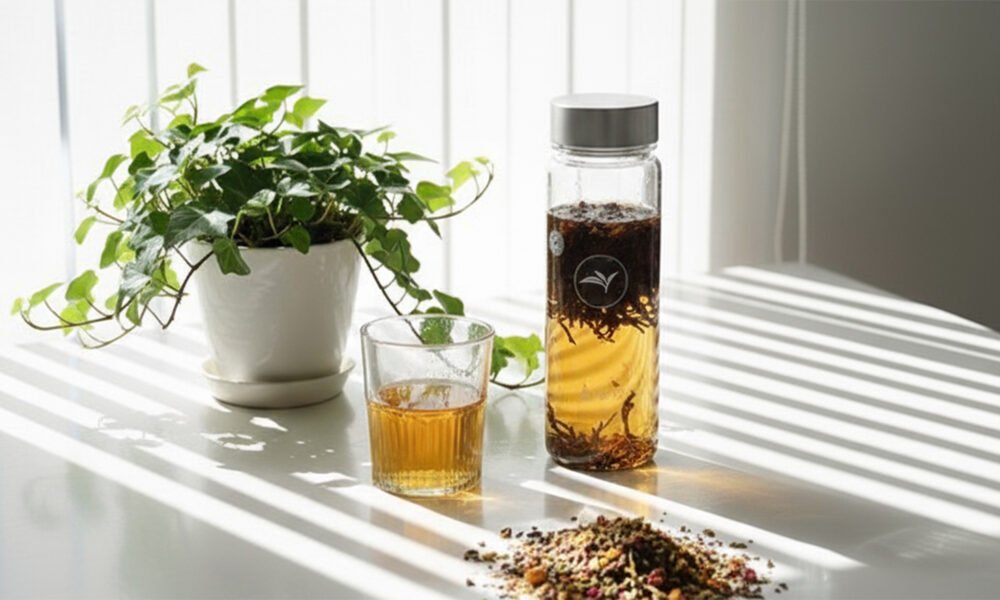
How to Brew Tea with Cold Water: A Refreshing Guide to Cold Brew Iced Tea
Index
Cold brewing creates a smooth, less bitter drink without the wait or hassle of ice diluting your tea.
This guide will walk you through simple steps to make perfect cold brew tea using basic items you already have in your kitchen. Get ready for the most refreshing tea you’ve ever tasted.
Key Takeaways
- Cold brew tea steeps in the refrigerator for 6-12 hours without using hot water. Green teas need 6-8 hours while black and oolong teas require 8-12 hours for best flavor.
- The cold brewing method creates a smoother, less bitter taste by extracting fewer tannins from tea leaves. This natural sweetness means you won’t need to add sugar.
- Cold brewed tea contains about half the caffeine of hot-brewed tea. This makes it better for afternoon or evening drinking without disrupting sleep.
- Use 1-1.5 teaspoons of loose leaf tea per 8 ounces (~250 ml) of filtered water for balanced flavor. For a 60-ounce (~1.75 liter) pitcher, you’ll need about 10 teaspoons of tea.
- Your cold brew tea stays fresh in the refrigerator for 3-5 days. Glass containers work best to prevent unwanted flavors from affecting your tea.
What is Cold Brew Iced Tea?

Cold brew iced tea brings a fresh twist to traditional tea making. This method combines loose-leaf tea or whole tea bags with cold water, then steeps slowly in your refrigerator for 6 to 12 hours.
Unlike hot-brewed tea that’s cooled down, true cold brew never touches hot water at any point in the process.
The magic happens during those long, patient hours in the fridge. Green teas need about 6-8 hours to develop their flavor, while black and oolong teas require 8-12 hours for best results.
This slow infusion creates a smooth tea without the bitterness that hot water can extract. Your finished cold brew stays fresh for several days, making it perfect for tea drinkers who value both taste and convenience.
Benefits of Cold Brewing Tea

Cold brewing tea offers more than just a cool drink on a hot day. You’ll find that cold water pulls different compounds from tea leaves, creating a smooth taste without the harsh bite that hot water can cause.
Smoother flavor
Cold brewing draws out tea flavors in a gentle way that hot water simply can’t match. The slow extraction process pulls fewer tannins from the leaves, creating a cup with almost no bitterness.
You’ll notice a natural sweetness that shines through without any added sugar. Many tea lovers switch to cold brew methods just for this smooth taste profile. The lack of harsh tannic notes makes even strong black teas taste mellow and refreshing.
This brewing method transforms even budget-friendly teas into premium-tasting drinks. Green teas develop a clean, grassy flavor without that astringent bite. Black teas release their rich notes without the mouth-puckering finish.
Herbal blends like hibiscus steep into vibrant, fruit-forward refreshments that taste sweet on their own. Next, we’ll explore how cold brewing reduces caffeine content while maintaining all these flavor benefits.
Less caffeine

Beyond its smoother taste, cold brew tea offers a major bonus for caffeine-sensitive people. Cold water pulls less caffeine from tea leaves than hot water does. This makes cold-brewed tea a milder option that won’t leave you jittery or awake at night.
Many tea drinkers report that cold brew sits better in their stomachs too.
You’ll notice the difference right away if you compare cold and hot brewed versions of the same tea. The cold method extracts about half the caffeine content while still delivering rich flavor.
While it’s a more forgiving option for later in the day, truly sensitive individuals may still want to switch to a caffeine-free herbal or fruit tea in the evening. Your body will thank you for this gentler approach to tea drinking.
Easy to prepare
Cold brew tea stands out for its simple preparation process. You combine tea with water and place it in the fridge, no boiling required. This method saves time and energy compared to heating water for hot tea.
The process takes just minutes to set up, then the refrigerator does all the work while you sleep or go about your day.
Tea lovers appreciate how this method fits into busy schedules. You can prepare a large batch in a pitcher that lasts 3-5 days in the refrigerator. The actual hands-on time involves only measuring tea leaves (about one teaspoon per 8 oz /~250 ml of water), adding cold filtered water, and later straining the mixture.
Even on your busiest mornings, you’ll have refreshing iced tea ready to pour and enjoy.
Step-by-Step Guide to Cold Brewing Tea
Follow our step-by-step guide to cold brewing tea for a simple process that yields perfect results every time, from selecting quality loose leaf tea to the ideal steeping time in your fridge – keep reading to master this refreshing method!

Choose your tea
The type of tea you select forms the foundation of your cold brew. Fruity and dessert-like flavors work best for cold brewing, creating refreshing summer drinks without added sweeteners.
Try Apricot Brandy for a sweet, fragrant option or Blueberry Pomegranate for a tangy, fruit-forward taste. Moroccan Mint offers a cooling sensation perfect for hot days. Many tea lovers enjoy Lavender Mint Herbal Tea for its calming properties or Sandia Sangria Oolong for its complex, wine-like notes.
Loose leaf tea gives you better results than tea bags for cold brewing. The larger leaves unfurl fully in cold water, releasing more flavor compounds over time. You’ll need about one teaspoon of loose tea per 8 ounces of water.
This ratio creates a balanced brew that isn’t too strong or weak. Black teas provide robust flavor, while green teas offer a lighter, more delicate taste. Herbal blends steep beautifully in cold water and don’t contain caffeine, making them great for evening enjoyment.
Measure the tea leaves
Getting the right amount of tea leaves makes all the difference in your cold brew. Start with 1 to 1.5 teaspoons of loose tea leaves per 8 ounces (~250 ml) of water. For a larger batch in a 60-ounce pitcher, you’ll need about 10 teaspoons of tea.
This ratio creates a balanced flavor that isn’t too weak or too strong.

You can adjust this measurement based on your taste preferences. If you enjoy a stronger brew, add an extra half teaspoon per cup. For a milder flavor, reduce the amount slightly. Using a kitchen scale or measuring spoon helps ensure consistency each time you make cold brew tea.
Fresh, quality loose tea leaves will give you the best flavor compared to tea bags.
Add cold, filtered water
Pour cold, filtered water into your container after you’ve added your tea leaves. Filtered water makes a huge difference in taste because it removes chemicals like chlorine that can ruin your brew.
You’ll want to fill the container completely, leaving just a small space at the top. This helps the tea steep evenly throughout the liquid.
Many tea lovers notice that tap water creates bitter notes in their cold brew. Using pure, filtered water instead brings out the natural sweetness and subtle flavors of your tea leaves.
The ratio matters too – aim for about 1-2 teaspoons of loose leaf tea per cup of water, adjusting based on how strong you prefer your iced tea to taste.
Refrigerate and steep

Place your container of tea and water in the fridge to work its magic. The cold water pulls flavors from the leaves slowly, creating a smooth taste without bitterness. Most teas need specific time frames for ideal results.
White and green teas reach their peak flavor after 6-8 hours in the refrigerator. Black and oolong teas require 8-12 hours to develop their full taste profile.
Your patience pays off with this method. The tea steeps gradually as it chills, which leads to less caffeine in your final drink. You might notice the color change as hours pass – this shows the brewing process is working.
Many tea lovers prepare their cold brew before bed to enjoy ready-to-drink refreshment the next day. The glass jar of iced tea waiting in your fridge makes hot summer days more bearable.
Strain and serve

You’ll need to remove the tea leaves or bags from your cold brew once it reaches your desired strength. Pour the tea through a fine mesh strainer into a clean pitcher to catch all the leaves.
For tea bags, simply lift them out with a spoon or tongs. This step stops the brewing process and prevents your tea from becoming too strong or bitter. The final product should look clear and have a smooth color without floating bits.
Serve your strained cold brew tea over ice in tall glasses for a refreshing drink. Many tea lovers enjoy adding fruit slices, herbs, or a splash of lemonade to their cold brew. The beauty of cold-steeped tea lies in its versatility – it tastes great plain or dressed up in tea cocktails.
You can even freeze it into tea popsicles for hot summer days. Your cold brew will stay fresh in the fridge for up to three days.
Alternative Brewing Methods: How to Brew Tea with a French Press
A French press offers a simple yet effective way to brew tea with cold water. This versatile tool creates smooth, flavorful cold brew tea without special equipment.
Step-by-Step Instructions

- Clean your French press thoroughly to ensure pure tea flavor
- Add tea leaves – Use 1-2 teaspoons of loose-leaf tea per cup of water
- Pour cold, filtered water slowly over the tea leaves to fully saturate them
- Place the lid on top without pressing the plunger down (this gives tea room to expand)
- Refrigerate for 8-12 hours depending on your desired strength
- Press the plunger down slowly to separate the leaves from the liquid
- Pour and serve into a pitcher or directly into ice-filled glasses
- Store leftovers in a sealed container in the fridge for up to 3 days
Why French Press Works So Well
French press brewing excels with larger tea leaves that need space to unfurl during steeping. The mesh filter effectively traps tea leaves while allowing the smooth, cold-brewed tea to flow through freely.
The glass chamber provides an added benefit—you can watch the brewing process and judge your tea’s color as it develops. This method enhances tea’s natural flavors while preventing the bitterness that often occurs with hot brewing techniques.
Your cold brew tea will stay fresh for up to three days when properly stored, giving you ready-to-drink refreshment whenever you want it.
Tips for the Perfect Cold Brew Tea
For the best cold brew tea, use filtered water to avoid unwanted flavors. The tea-to-water ratio matters too – we suggest one teaspoon of loose leaf tea per cup of water for balanced flavor.
Loose-leaf varieties yield superior results, though quality tea bags work fine in a pinch. Steep your tea in the refrigerator rather than at room temperature to prevent bitterness.
Green and white teas need 6-8 hours of steeping, while black and oolong teas require 8-12 hours for full flavor development.

Your brewing container makes a difference in the final taste. Glass pitchers or jars prevent unwanted flavors from leaching into your brew. After straining, store your cold brew tea in the refrigerator for 3-5 days without losing freshness.
Try adding fresh fruit slices, herbs like mint, or a splash of lemon juice to create your own signature iced tea blend. These small adjustments transform a simple cold brew into a refreshing summer drink that tastes smooth with less caffeine than hot-brewed methods.
Conclusion
Cold brew tea brings a fresh twist to your summer drinks with its smooth flavor and simple prep. You’ll enjoy less bitterness and reduced caffeine while saving time on your busy days.
Making this refreshing beverage needs just tea leaves, water, and patience as it steeps in your fridge. Try different tea types like fruity blends or classic black tea to find your perfect match.
Cold brewing opens up a world of tea enjoyment that stays fresh for days, making it an ideal choice for hot weather refreshment.
FAQs
1. What is cold brew tea and how is it different from regular tea?
Cold brew tea involves steeping tea leaves in fresh cold water rather than hot water. Unlike regular tea, cold-brewing tea creates a smoother, less bitter taste because the cold water extracts flavors slowly. This method takes more time but rewards you with a great tea that’s ready to drink.
2. How long should I cold steep my tea?
The ideal steeping time depends on the type of tea. For green and white teas, steep for 6-8 hours. For black and oolong teas, a longer steep of 8-12 hours is needed to fully develop their flavor. Preparing it the night before is an easy way to ensure it’s ready.
3. What’s the best tea-to-water ratio for cold brewing?
For loose leaf tea, use 1 to 1.5 teaspoons for every 8 ounces (~250 ml) of water. For tea bags, one bag per 8 ounces of water is a good starting point. You can adjust these amounts based on your personal taste for a stronger or milder brew.
4. Can all types of tea be cold brewed?
Yes, all teas can be cold brewed. Black teas like Lipton or Luzianne tea work well, but you can also try green, white, or herbal teas like Rooibos. Each tea type offers unique flavors when cold brewed.
5. Is sun tea the same as cold brew tea?
No. Sun tea uses the sun’s heat to brew tea, while cold brewing tea uses only cold water and time. Cold brewing is safer because it doesn’t create the warm environment that can grow bacteria, which sometimes happens with sun tea.
6. How do I serve cold brew tea?
Simply remove the tea bags or strain out the tea leaves when your tea is ready. Serve over ice in a glass for a refreshing unsweetened iced tea. You can add sweeteners, milk, or fruits like blackberry if desired.
References
- https://cookieandkate.com/cold-brew-iced-tea/
- https://www.seriouseats.com/how-to-make-the-best-cold-brew-iced-tea (2018-08-10)
- https://www.artoftea.com/blogs/recipes/six-benefits-cold-brew-tea
- https://artfultea.com/blogs/101/how-to-cold-brew-tea?srsltid=AfmBOop_pQzH-8rg1mReDCjmGYbTuAsTD7rA5TyXANtVf7jSt-H3H3LK
- https://artfultea.com/blogs/101/how-to-cold-brew-tea?srsltid=AfmBOorvMirwMviHKtXqvt0-iC0Wafzf28aZJb1uZJCOd_k7xn_uTqlv
- https://paperstcoffee.com/blogs/news/cold-brew-tea-basics-step-by-step

